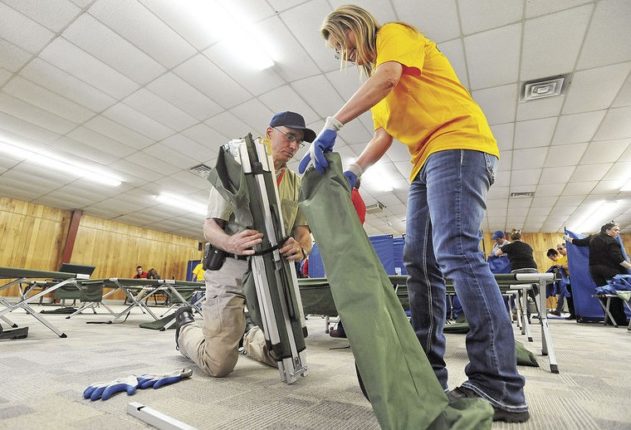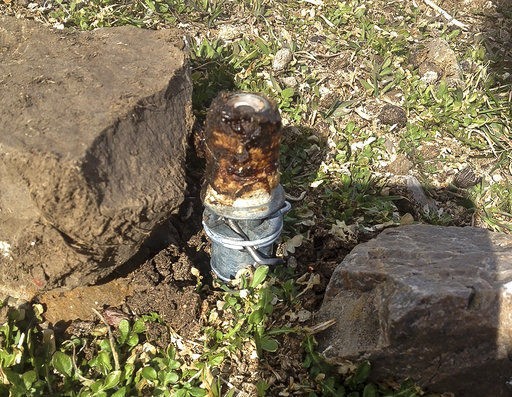POCATELLO — As he walked his dog along the ridgeline of the hillside just south of his family’s home on West Buckskin Road, 14-year-old Canyon Mansfield noticed what he thought was a sprinkler head protruding 6 inches from the ground.
Like many curious teenagers would, he bent down and touched the pipe, which erupted with a loud popping noise that knocked Canyon off his feet. A hissing sound ensued and Canyon noticed his clothing and face were covered with an orange, powdery substance. After quickly washing his face and clothes in a nearby patch of snow, he called for his dog, a 3-year-old Lab named Casey.
But Canyon’s best friend didn’t respond.
“He just stayed on the ground mumbling,” Canyon said. “I thought he was playing with his toy, but I saw the toy a couple yards away from him. … So, I called him again and got really scared. I sprinted toward him and landed on my knees and saw this red froth coming from his mouth and his eyes turning glassy and he was having a seizure.”
Within minutes, Casey was dead.
“My little brother is lying in bed crying next to me,” said Canyon’s sister, Madison Mansfield. “He spent yesterday in the emergency room after stumbling upon an unmarked cyanide bomb in the woods directly behind my home. He watched his best friend suffocate as sodium cyanide was deposited in his mouth.”
Canyon was taken to Portneuf Medical Center, where he was treated and released. But he must continue daily follow-up appointments to check toxicity levels.
On Thursday afternoon, Casey joined thousands of other non-targeted animals — both wild and domestic — that have been mistakenly killed by one of the most lethal tools at the disposal of the U.S. Department of Agriculture — spring-loaded metal cylinders that are baited with scent that shoot sodium cyanide powder into the mouth or face of whatever or whoever touches them.
Known as M-44 devices, the Animal and Plant Health Inspection Service (APHIS) division of the USDA deploys these sodium cyanide capsules throughout the West to protect livestock from coyotes, wild dogs, and red and gray foxes.
M-44s are hollow metal tubes 5 to 7 inches long that are driven into the ground, loaded with 0.9 grams of sodium cyanide and coated with the smelliest bait possible.
Though the devices are legal methods of controlling local predators, the legality regarding the manner in which the device that killed Casey was planted remains under investigation.
On Friday, APHIS released the following statement regarding the incident:
“APHIS’ Wildlife Services confirms the unintentional lethal take of a dog in Idaho. As a program made up of individual employees many of whom are pet owners, Wildlife Services understands the close bonds between people and their pets and sincerely regrets such losses. Wildlife Services has removed M-44s in that immediate area. Wildlife Services is completing a thorough review of the circumstances of this incident, and will work to review our operating procedures to determine whether improvements can be made to reduce the likelihood of similar occurrences happening in the future.”
The spokesman for APHIS, R. Andre Bell, said in a Friday statement that “the unintentional lethal take of a dog is a rare occurrence (and Wildlife Services) posts signs and issues other warnings to alert pet owners when wildlife traps or other devices are being used in an area for wildlife damage management.”
The statement also said that M-44 devices are only set at the request of and with permission from property owners or managers, and that this is the first unintentional take of an animal with an M-44 device in Idaho since 2014.
“The USDA’s statement regarding the horrific incident that happened to my family yesterday is both disrespectful and inaccurate,” Madison said. “The USDA intentionally refers to the brutal killing of our dog as a ‘take’ to render his death trivial and insignificant.”
She continued, “They also claim that the killing of an unintended victim is a rare occurrence, but this is entirely untrue. In fact, this issue is nationally recognized due to the lack of selectivity of cyanide bombs, and there have been many reported incidents in which unintended animals and people have been targeted.”
On March 11 near Casper, Wyoming, a national nonprofit advocacy organization called Predator Defense reported that two families out on a hiking trip, including an 8-year-old girl, watched two of their four canine companions die after uncovering unmarked cyanide devices.
When deploying these “cyanide bombs,” applicators must adhere to several guidelines that include requesting permission from the landowners and posting warning signs in both Spanish and English.
However, Canyon said he did not see any posted signs.
“The guy that planted them there said he got consent,” Canyon said. “And he said he put signs up but I would have noticed it because I go up there all the time.”
There were no obvious warning signs, according to Bannock County Sheriff Lorin Nielsen, but as of Friday afternoon, his deputies were still investigating.
“The trapper that set those for the federal government did show up, we were able to interview him and he has disarmed those that are in that area, and hopefully the rest of the county,” Nielsen said.
The identity of the individual who set the cyanide traps could not be confirmed as of Friday afternoon, but Nielsen did confirm the individual is an employee of APHIS.
The Bannock County Sheriff’s Office believes the incident happened on Bureau of Land Management land south of the Mansfield’s property. However, the BLM said Friday the incident did not happen on its land.
“I’ve been sheriff for 20-plus years and I have never heard of these before,” Nielsen said about the cyanide bombs. “It just doesn’t make a whole lot of sense to have a landmine-type device that disperses cyanide gas.”
Cyanide is notoriously known as one of the fastest-acting poisons to ever exist. Yet it’s so uncommon that the Bannock County Sheriff’s deputies, Canyon’s father, Mark, who is a local doctor, and the doctor at the emergency room didn’t immediately know how to handle the situation.
The poison works by binding to hemoglobin, the molecule in red blood cells responsible for transporting oxygen throughout the body. It then prevents the cells from using oxygen to make energy molecules. Essentially, cyanide suffocates the victim exposed to it from the inside out.
“Not only is cyanide unethical, the antidote is highly ineffective and can rarely be administered in time to treat it,” Madison said. “My dog suffered as he struggled for breath while my brother stood helplessly nearby. This is not humane, and no animal, dog or coyote should ever be killed in such a gruesome manner.”
APHIS agency records show that more than 3,400 animals have been mistakenly killed by M-44s between 2006 and 2012. These include black bears, bobcats, raccoons, opossums, ravens, ringtails, red fox, gray fox, kit fox, swift fox, turkey vultures and dogs, according to the Sacramento Bee.
At least 18 employees and several members of the public have also been exposed to cyanide over the past 25 years. None died, but many were treated for nausea, blurred vision and other symptoms, the Sacramento Bee reported.
“The placement of these unmarked devices in a residential area without notifying the families and the authorities is grossly negligent,” Madison said. “The individual who placed the bombs is most certainly not ‘highly-trained’ as the USDA claims. If he was, he would have noticed the homes clearly beneath him and this tragedy could have been easily avoided.”
Some of the cyanide devices used to control predator populations are manufactured at Pocatello Supply Depot in Pocatello.
In July 2014, Pocatello Supply Depot transitioned from being a private company and became a fully federalized facility operated exclusively by Wildlife Services, according to documents posted to APHIS’s website.
Canyon’s mother, Theresa Mansfield, said she wants to make the public aware of this situation and doesn’t want to see another pet or child put in danger.
“This is horrific,” Theresa said. “This is like terrorism in my backyard.”








